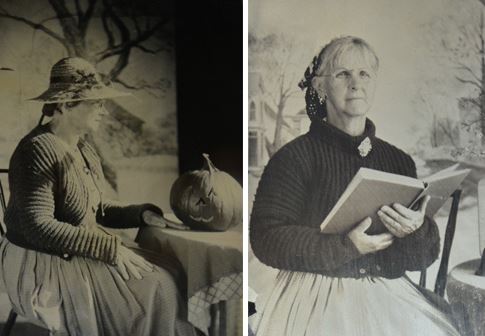Wet plate photographers return and gather at Canada’s oldest collodion studio
By Joanne Jordan, Local Journalism Initiative Reporter
Guysborough Journal
SHERBROOKE: A shared passion for 19th-century photography brought a small group of artists together at Sherbrooke Village Museum recently – their first wet plate and ambrotype photography gathering since the inaugural event in 2017.
“It was a gathering of like-minded artists,” said interpreter and ambrotype photographer Suzette Jordan (Cameron), in an interview with The Journal about the event, which occurred Aug. 23-24.
That weekend saw photographers gather in the living history museum’s period-accurate setting to share techniques, equipment and experiences with the collodion film process, patented in 1854.
The event, inspired by Jordan (Cameron), Susan Hayne, Angelina Jack and retired photographer Dale Wilson, was born of their desire for connections and collaborations, said Jordan (Cameron).
“Due to external pressures and the COVID-19 restrictions, 2025 was the first opportunity to revisit the initiative,” Wilson explained to The Journal in an email. The group grew as the original four photographers from the first gathering were joined by others.
Aiming to foster learning across skill levels, the gathering was “for sharing experience and exposing our visitors to the process and its portable abilities, and growing popularity with photographers,” Jordan (Cameron) said. Wilson, who attended the 2017 gathering and remains a strong advocate for the studio and the photographers there, said the goal of an annual gathering would be “to create a learning environment for beginners to advanced photographers, in order to retain a process knowledge base.”
Noting the gathering was “invaluable to those who attended,” Jordan (Cameron) said this year’s event “was long overdue.”
“For myself, it was a dream come true,” she said, of seeing six sets of portable darkroom tents, boxes and cameras “set up around our museum, creating one-of-a-kind imagery.”
Collaborating with wet plate photographers at historic Sherbrooke Village during the 2025 weekend “was a privilege,” said Wilson.
“I also had the honour of representing Canada’s only wet plate chemistry retailer,” he added, noting that Yves Lavoie and Antique Pictureology “graciously supported our activities by making a donation to the museum.”
Sherbrooke Village is home to the longest continuously operating ambrotype studio in Canada – and perhaps in North America. Opened in May 1976, the studio will mark its 50th anniversary next year.
Originally a tintype studio – chemically the same as today’s process, though using a different medium (glass rather than metal) – the studio’s beginnings would not have been possible without the inspiration, hard work and passion of Peter Murphy, Archie MacLellan and J.D. Fraser, said Jordan (Cameron), noting how those men laboured for three years to resurrect an obsolete photo process.
Sherbrooke Village Museum is the only location in Canada where contemporary photographers can pursue the wet plate collodion process among a streetscape and costumed interpreters accurate to 1876 – a time when early photography was at its height. A flammable, syrupy solution of nitrocellulose in ether and alcohol, collodion was first introduced in the mid-1800s, revolutionizing photography and becoming a key component in the wet plate process. It allowed for the creation of negatives and multiple prints.
Jordan (Cameron) noted that collodion requires an on-site darkroom to produce hand-sensitized plates one at a time, “where you will be mixing flammable and poisonous chemicals, mastering hand skills, and facing an extensive learning curve.”
She and Hayne have been creating ambrotype photos and sharing the history at Sherbrooke Village since 1998, while Angelina Jack – now director of visitor experience at the Village – worked alongside them for eight of those years.
Despite the dominance of digital photography today, interest in historical photographic methods remains strong. The group of four who first gathered in 2017 “affectionately and quite by accident began referring to those with a passion for collodion photography as ‘collodion creatures,’” said Jordan (Cameron).
She added, “Sherbrooke Village stands as one of the most extensively beautiful collections of buildings and historically accurately dressed interpretive staff. It’s the perfect backdrop for photographic exploration and creative artistry.”
Jordan (Cameron)’s use of old-method photography extends beyond the museum.
“When we travelled to Iona this summer, we used a portable system – the same process produced in the field as it would have been during the Civil War in the USA, 1862 to 1865-ish,” she said, explaining that they used a gravity-fed water system, candles to heat and dry plates, ceramic trays for rinsing, and a portable darkroom on wheels. Jordan (Cameron) added, “It was quite the event, really.”
She said it has been “my passion to get the darkroom portable, adding, “With support, it’s become a reality.”
Reflecting on her years at Sherbrooke Village, Jordan (Cameron) said the work is “a complete gift,” adding, “I love it more than words can say – it’s been a wonderful journey.”


